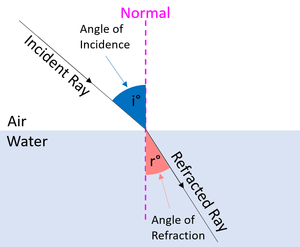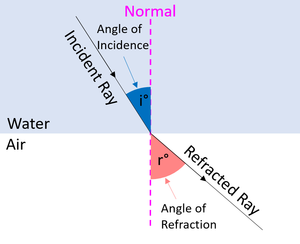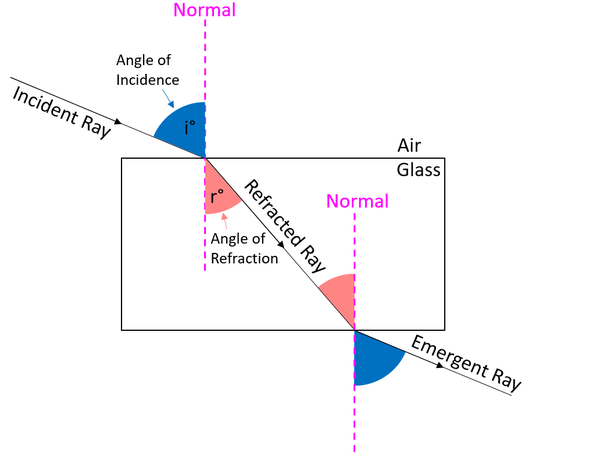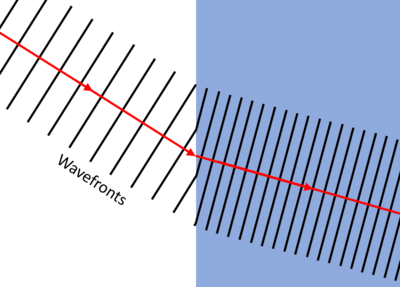Difference between revisions of "Refraction"
(→Refraction of Light) |
|||
| Line 28: | Line 28: | ||
: [[Refracted Ray]] - Once the [[Light Ray|ray]] passes the boundary it is called a [[Refracted Ray|refracted ray]]. | : [[Refracted Ray]] - Once the [[Light Ray|ray]] passes the boundary it is called a [[Refracted Ray|refracted ray]]. | ||
: [[Normal Line|Normal]] - The [[Normal Line|normal line]] is an imaginary line drawn at [[Right Angle|right angles]] to the boundary between two [[Medium|media]]. | : [[Normal Line|Normal]] - The [[Normal Line|normal line]] is an imaginary line drawn at [[Right Angle|right angles]] to the boundary between two [[Medium|media]]. | ||
| + | : [[Angle of Incidence]] - The [[angle]] between the [[Incident Ray]] and the [[Normal Line|Normal]] is called the [[Angle of Incidence|angle of incidence]]. | ||
| + | : [[Angle of Refraction]] - The [[angle]] between the [[Refracted Ray]] and the [[Normal Line|Normal]] is called the [[Angle of Refraction|angle of refraction]]. | ||
| + | : [[Emergent Ray]] - When a [[Light Ray|ray]] enters and then leaves a new [[medium]] the [[Light Ray|ray]] that leaves is called an [[Emergent Ray|emergent ray]]. | ||
| + | |||
| + | ==Key Stage 4== | ||
| + | ===Meaning=== | ||
| + | [[Refraction]] is when a [[wave]] changes direction as it crosses the [[interface]] between two [[medium|media]]. | ||
| + | |||
| + | ===About Refraction=== | ||
| + | : [[Wave]]s travel in a straight line until they reach an [[interface]] with a new [[medium]]. If the [[wave]] can be [[transmitted]] through the new [[medium]] it will change direction. This is called [[refraction]]. | ||
| + | : [[Refraction]] is caused by a [[wave]] changing [[Wave Speed|speed]] as it crosses an [[interface]] from one [[medium]] into another. | ||
| + | : When a [[wave]] '''refracts''' the [[frequency]] remains constant but the [[wavelength]] and [[Wave Speed|wave speed]] change. | ||
| + | |||
| + | {| class="wikitable" | ||
| + | |- | ||
| + | |[[File:RefractionSpeed.png|center|400px]] | ||
| + | |- | ||
| + | | style="height:20px; width:200px; text-align:center;" |This [[diagram]] shows the [[wavefront]]s of a [[wave]] arrive at an [[interface]] where they slow down. The [[wave]] changes direction because one side of the [[wavefront]] slows before the other side. | ||
| + | |} | ||
| + | |||
| + | ===Refraction of Light=== | ||
| + | : When [[light]] crosses the [[interface]] between two [[transparent]] [[medium|media]] it is '''refracted'''. | ||
| + | {| class="wikitable" | ||
| + | |- | ||
| + | |[[File:LightRefraction1.png|center|300px]] | ||
| + | |[[File:LightRefraction2.png|center|300px]] | ||
| + | |- | ||
| + | | style="height:20px; width:200px; text-align:center;" |When a [[Light Ray|ray of light]] moves from [[air]] into [[water]] the [[Light Ray|ray]] is '''refracted''' towards the [[normal]]. | ||
| + | | style="height:20px; width:200px; text-align:center;" |When a [[Light Ray|ray of light]] moves from [[water]] into [[air]] the [[Light Ray|ray]] is '''refracted''' away from the [[normal]]. | ||
| + | |} | ||
| + | |||
| + | {| class="wikitable" | ||
| + | |- | ||
| + | |[[File:RefractionGlassBlock.png|center|600px]] | ||
| + | |- | ||
| + | | style="height:20px; width:200px; text-align:center;" |When a [[Light Ray|ray of light]] moves from [[air]] into [[glass]] the [[Light Ray|ray]] is '''refracted''' towards the [[normal]] and when it moves from [[glass]] into [[air]] the [[Light Ray|ray]] is '''refracted''' away from the [[normal]] | ||
| + | |} | ||
| + | |||
| + | : [[Incident Ray]] - A [[Light Ray|ray]] is called an [[Incident Ray|incident ray]] before it reaches the [[interface]] between two [[Medium|media]]. | ||
| + | : [[Refracted Ray]] - Once the [[Light Ray|ray]] passes the [[interface]] it is called a [[Refracted Ray|refracted ray]]. | ||
| + | : [[Normal Line|Normal]] - The [[Normal Line|normal line]] is an imaginary line drawn at [[Right Angle|right angles]] to the [[interface]] between two [[Medium|media]]. | ||
: [[Angle of Incidence]] - The [[angle]] between the [[Incident Ray]] and the [[Normal Line|Normal]] is called the [[Angle of Incidence|angle of incidence]]. | : [[Angle of Incidence]] - The [[angle]] between the [[Incident Ray]] and the [[Normal Line|Normal]] is called the [[Angle of Incidence|angle of incidence]]. | ||
: [[Angle of Refraction]] - The [[angle]] between the [[Refracted Ray]] and the [[Normal Line|Normal]] is called the [[Angle of Refraction|angle of refraction]]. | : [[Angle of Refraction]] - The [[angle]] between the [[Refracted Ray]] and the [[Normal Line|Normal]] is called the [[Angle of Refraction|angle of refraction]]. | ||
: [[Emergent Ray]] - When a [[Light Ray|ray]] enters and then leaves a new [[medium]] the [[Light Ray|ray]] that leaves is called an [[Emergent Ray|emergent ray]]. | : [[Emergent Ray]] - When a [[Light Ray|ray]] enters and then leaves a new [[medium]] the [[Light Ray|ray]] that leaves is called an [[Emergent Ray|emergent ray]]. | ||
Revision as of 13:25, 19 February 2019
Contents
Key Stage 3
Meaning
Refraction is when a wave changes direction as it moves from one medium to another.
About Refraction
- Waves travel in a straight line until they reach a new medium. If the wave can travel through the new medium it will change direction. This is called refraction.
- Refraction can happen to all waves.
Refraction of Light
- When light moves from one transparent medium to another it is refracted.
| When a ray of light moves from air into water the ray is refracted towards the normal. | When a ray of light moves from water into air the ray is refracted away from the normal. |
| When a ray of light moves from air into glass the ray is refracted towards the normal and when it moves from glass into air the ray is refracted away from the normal |
- Incident Ray - A ray is called an incident ray before it reaches the boundary between two media.
- Refracted Ray - Once the ray passes the boundary it is called a refracted ray.
- Normal - The normal line is an imaginary line drawn at right angles to the boundary between two media.
- Angle of Incidence - The angle between the Incident Ray and the Normal is called the angle of incidence.
- Angle of Refraction - The angle between the Refracted Ray and the Normal is called the angle of refraction.
- Emergent Ray - When a ray enters and then leaves a new medium the ray that leaves is called an emergent ray.
Key Stage 4
Meaning
Refraction is when a wave changes direction as it crosses the interface between two media.
About Refraction
- Waves travel in a straight line until they reach an interface with a new medium. If the wave can be transmitted through the new medium it will change direction. This is called refraction.
- Refraction is caused by a wave changing speed as it crosses an interface from one medium into another.
- When a wave refracts the frequency remains constant but the wavelength and wave speed change.
| This diagram shows the wavefronts of a wave arrive at an interface where they slow down. The wave changes direction because one side of the wavefront slows before the other side. |
Refraction of Light
- When light crosses the interface between two transparent media it is refracted.
| When a ray of light moves from air into water the ray is refracted towards the normal. | When a ray of light moves from water into air the ray is refracted away from the normal. |
| When a ray of light moves from air into glass the ray is refracted towards the normal and when it moves from glass into air the ray is refracted away from the normal |
- Incident Ray - A ray is called an incident ray before it reaches the interface between two media.
- Refracted Ray - Once the ray passes the interface it is called a refracted ray.
- Normal - The normal line is an imaginary line drawn at right angles to the interface between two media.
- Angle of Incidence - The angle between the Incident Ray and the Normal is called the angle of incidence.
- Angle of Refraction - The angle between the Refracted Ray and the Normal is called the angle of refraction.
- Emergent Ray - When a ray enters and then leaves a new medium the ray that leaves is called an emergent ray.



